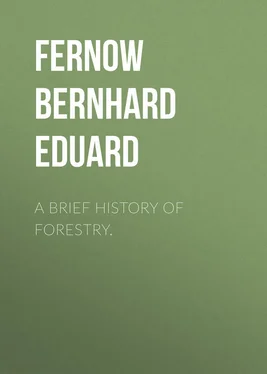Bernhard Fernow - A Brief History of Forestry.
Здесь есть возможность читать онлайн «Bernhard Fernow - A Brief History of Forestry.» — ознакомительный отрывок электронной книги совершенно бесплатно, а после прочтения отрывка купить полную версию. В некоторых случаях можно слушать аудио, скачать через торрент в формате fb2 и присутствует краткое содержание. Жанр: foreign_antique, foreign_prose, на английском языке. Описание произведения, (предисловие) а так же отзывы посетителей доступны на портале библиотеки ЛибКат.
- Название:A Brief History of Forestry.
- Автор:
- Жанр:
- Год:неизвестен
- ISBN:нет данных
- Рейтинг книги:5 / 5. Голосов: 1
-
Избранное:Добавить в избранное
- Отзывы:
-
Ваша оценка:
- 100
- 1
- 2
- 3
- 4
- 5
A Brief History of Forestry.: краткое содержание, описание и аннотация
Предлагаем к чтению аннотацию, описание, краткое содержание или предисловие (зависит от того, что написал сам автор книги «A Brief History of Forestry.»). Если вы не нашли необходимую информацию о книге — напишите в комментариях, мы постараемся отыскать её.
A Brief History of Forestry. — читать онлайн ознакомительный отрывок
Ниже представлен текст книги, разбитый по страницам. Система сохранения места последней прочитанной страницы, позволяет с удобством читать онлайн бесплатно книгу «A Brief History of Forestry.», без необходимости каждый раз заново искать на чём Вы остановились. Поставьте закладку, и сможете в любой момент перейти на страницу, на которой закончили чтение.
Интервал:
Закладка:
The use of the Waldfeldbau (combined farm and forest culture) was also inaugurated for the purpose of cheapening the cost of plantations (by v. Langen in 1744) when the great movement for reforesting wastes and openings began, the tree seed being sown with the grain either at once or after farm use for some years.
Regular annual planting budgets (of $50 – $100 – $200) were inaugurated in Brunswick by v. Langen in 1745; and in 1781, the Prussian forest administration had attained to entirely modern planting plans and annual planting budgets.
It was no wonder that the fear of a timber famine and the apparent hopelessness of bringing improvement into the existing forest conditions created anxiety and a desire to plant rapid growers , such as birch, willow, aspen, alder; the planting of the White Birch became so general in the beginning of the 18th century that a regular betulomania is recorded corresponding to the incipient catalpomania in the United States.
At that time, to be sure, firewood was still the main concern, and the use of these rapid growing species had some justification. But where birch was mixed in spruce plantations its baneful effects consisting in whipping off the spruce tips and injuring its neighbors were soon recognized, and much trouble was experienced in getting rid of the unwelcome addition.
The Robinia , which had been brought from America in 1638, was also one of the trees recommended in the middle of the 18th century and was much planted until Hartig pointed out that the expectations from it were entirely misplaced.
Of course no building material could be expected from these species, hence the larch, also a rapid grower, was transplanted from the Alps (1730 in Harz mountains), and its use was extended, as with us, to conditions for which it was not adapted.
It was principally a desire for novelty and perhaps for better, especially foreign things, that led to the planting of North American species in parks during the first half of the 18th century. But, although F. A. J. von Wangenheim’s very competent writings on the American forest-flora and on the laws of naturalization (1787) stimulated interest in that direction, the use of American species for forest planting was not inaugurated till nearly 100 years later, with the single exception of the White Pine ( P. strobus ), of which large numbers were planted.
7. Improvement of the Crop
Thinning of stands had been practiced early in the 16th century, not for improvement of the remaining stand so much as to secure fence material, although in 1531 the observation was already recorded that thinning improved and stimulated the remaining growth.
In the 17th century, opposite views, or, at least doubts as to its usefulness were expressed in the forest orders, and sometimes thinning was even forbidden. Even in the 18th century some of the prominent foresters, Doebel and Beckman, were opposed to it, and although others favored the operation, the practice of it remained limited.
In 1761, we find the first good statement of the theory of thinnings by Berlepsch, who advised taking out the suppressed trees when the sound poles were clear of lower and middle branches; he also accentuated the financial argument of earlier returns and increased value of the remainder.
About the same time, Zanthier recommended two thinnings, namely, for conifers first in the thirtieth to fortieth year and again in the fiftieth year, for broadleaf forest first in the forty-fifth and again in the eightieth to ninetieth year.
In 1765, the financial gain from thinnings is figured by Oettelt, and the possible reduction of the rotation due to thinnings is recognized by Leubert in 1774.
Just as the thinning in polewoods arose from the need of earlier utilization, so the weeding of young growths was done for the purpose of getting material for withes to bind the grain, etc.
The removal of coppice shoots in oak plantings was practiced in Prussia in 1719, and the thinning of too dense sowings was advised by Carlowitz in 1713. Yet much later, even such an intelligent man as Oettelt inveighed against the weeding out of the birch in spruce sowings because “nature prefers variety, with which preference it is not good to interfere.”
This was in opposition to v. Langen (1745), who prescribed for the first time regular cleaning or weeding, especially the removal of the softwoods, aspen and birch, and of coppice shoots from seedling forest. It was also known that this weeding is best done “in the full sap,” in order to kill the stocks.
8. Methods of Regulating Forest Management
Organized forest management was slower to develop than silvicultural methods. The first attempts to bring order into the progress of fellings took the form of dividing the whole area into a certain number of felling areas (12, 16, 20, 30, etc.), several ordinances dating from the middle of the 15th and 17th centuries containing prescriptions to that effect.
It is doubtful whether the numbers of these areas indicate years of rotation, in which case they could only have applied to coppice, or whether they indicate periods of return in selection forest, although the historians seem to jump to the former conclusion. The area division practiced by v. Langen in the Harz mountains (1745), who prescribed the division of larger districts into fifty to sixty, of smaller districts into twenty to thirty felling areas, also leaves it doubtful, whether the areas corresponded to an assumed rotation or to a period of return.
At first, the division was not into equal areas, for no survey existed, and its object was simply to localize the cutting and provide orderly progress. The subdivision was made in the mountain country by following the topography, valleys and ridges, while in the plain the lines opened up for purposes of the chase (to set up nets), called Schneisen or Gestelle (rides), bounding square areas called Jagen , Quadrat , Stallung , were used for the limitation of the felling areas. Most commonly, however, largely due to absence of surveys, the ordered division did not materialize, but existed only on paper.
With more exact measuring of areas, and with the conception of a rotation or longer periods of return, it was recognized that the inequality of the sites or soil qualities, especially in mountain districts, produced very unequal felling budgets. To overcome this inequality, Jacobi, in Goettingen (1741) introduced proportional felling areas, making the felling areas on poor sites permanently larger.
Similarly, v. Langen and Zanthier attempt to secure equal annual returns without slavishly holding to the geometric division, merely making sure that the total area be cut over in the predetermined rotation.
The first attempts to introduce a regulated management by making a volume division the basis is recorded from the Harz mountains in 1547. This method, based on very crude estimates although upon very fair forest description, was continued into the 18th century.
In the last half of the 18th century all these crude methods were improved, and applied on extensive areas.
In 1785, Zanthier combined area and volume division, determining the felling budget on each felling area by counting and estimating the trees and calculating how many trees could be used annually under a sustained yield management; the area division being used only as a check or means of control.
A very considerable advance was made by Oettelt, (who surveyed and regulated the Weimar forests in 1760) in the elaboration of details and establishment of proper principles for regulating the felling budget.
In his forest description he introduces for the first time periodic age classes, usually six, but of uneven length: Young growth, below twelve years; thicket, twelve to twenty-four years; polewood, twenty-four to forty years; clear timber, forty to fifty; medium timber, fifty to seventy-five; mature timber, seventy-five years and over.
Читать дальшеИнтервал:
Закладка:
Похожие книги на «A Brief History of Forestry.»
Представляем Вашему вниманию похожие книги на «A Brief History of Forestry.» списком для выбора. Мы отобрали схожую по названию и смыслу литературу в надежде предоставить читателям больше вариантов отыскать новые, интересные, ещё непрочитанные произведения.
Обсуждение, отзывы о книге «A Brief History of Forestry.» и просто собственные мнения читателей. Оставьте ваши комментарии, напишите, что Вы думаете о произведении, его смысле или главных героях. Укажите что конкретно понравилось, а что нет, и почему Вы так считаете.












